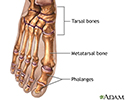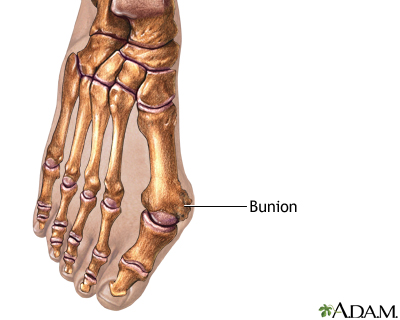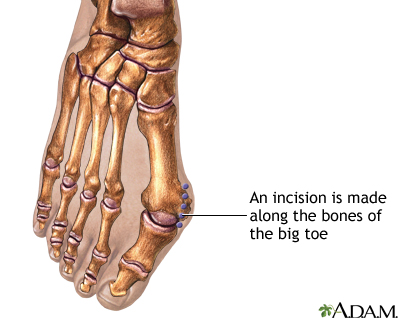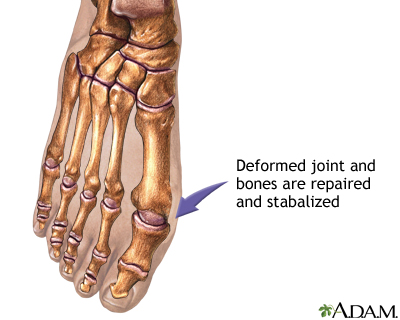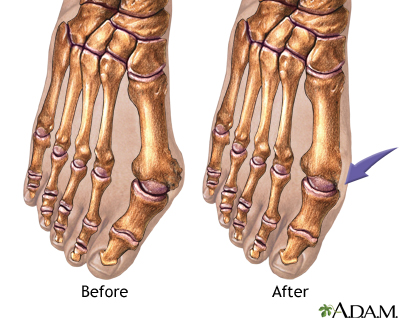Bunion removal
Bunionectomy; Hallux valgus correction; Bunion excision; Osteotomy - bunion; Exostomy - bunion; Arthrodesis - bunionBunion removal is surgery to treat deformed bones of the big toe and foot. A bunion occurs when the big toe points outward toward the second toe, forming a bump on the inner side of the foot.
Bunion
A bunion forms when your big toe points outward toward your second toe. This causes a bump to appear on the inside edge of your toe.

Description
You will be given anesthesia (numbing medicine) so that you won't feel pain.
- Local anesthesia -- Your foot may be numbed with pain medicine. You may also be given medicines that relax you. You will stay awake.
-
Spinal anesthesia -- The pain medicine is injected into a space in your spine. You will be awake but will not be able to feel anything below your waist.
Spinal anesthesia --
Spinal and epidural anesthesia are procedures that deliver medicines that numb parts of your body to block pain. They are given through shots in or ...
 ImageRead Article Now Book Mark Article
ImageRead Article Now Book Mark Article - Regional anesthesia -- The pain medicine is injected into your leg. It will numb your lower leg and foot. You may still require general anesthesia to make you sleep through the procedure. However, the amount of anesthesia needed is much less as you cannot feel your leg during surgery.
-
General anesthesia -- You will be asleep and pain-free.
General anesthesia --
Spinal and epidural anesthesia are procedures that deliver medicines that numb parts of your body to block pain. They are given through shots in or ...
 ImageRead Article Now Book Mark Article
ImageRead Article Now Book Mark Article
The surgeon makes a cut around the toe joint and bones. The deformed joint and bones are lined up using pins, screws, plates, or a splint to keep the bones in place.
The surgeon may repair the bunion by:
- Making certain tendons or ligaments shorter or longer
- Taking out the damaged part of the joints and then using screws, wires, or a plate to hold the joint together so that they can fuse
- Shaving off the bump on the toe joint
- Removing the damaged part of the joint
- Cutting parts of the bones on each side of the toe joint, and then putting them in their proper position
Why the Procedure Is Performed
Your health care provider may recommend this surgery if you have a bunion that has not gotten better with other treatments, such as shoes with a wider toe box. Bunion surgery corrects the deformity and relieves pain caused by the bump.
Risks
Risks of anesthesia and surgery in general include:
- Allergic reactions to medicines
-
Breathing problems
Breathing problems
Breathing difficulty may involve:Difficult breathing Uncomfortable breathingFeeling like you are not getting enough air
 ImageRead Article Now Book Mark Article
ImageRead Article Now Book Mark Article -
Bleeding, blood clots, or infection
Bleeding
Bleeding is the loss of blood. Bleeding may be:Inside the body (internal)Outside the body (external)Bleeding may occur:Inside the body when blood le...
 ImageRead Article Now Book Mark Article
ImageRead Article Now Book Mark ArticleBlood clots
Blood clots are clumps that occur when blood hardens from a liquid to a solid. A blood clot that forms inside one of your veins or arteries is calle...
 ImageRead Article Now Book Mark Article
ImageRead Article Now Book Mark Article
Risks of bunion surgery include:
- Numbness in the big toe.
- The wound does not heal well.
- The surgery does not correct the problem.
- Instability of the toe.
- Nerve damage.
- Persistent pain.
- Stiffness in the toe.
-
Arthritis in the toe.
Arthritis
Arthritis is inflammation or degeneration of one or more joints. A joint is the area where 2 bones meet. There are more than 100 different types of...
 ImageRead Article Now Book Mark Article
ImageRead Article Now Book Mark Article - Worse appearance of the toe.
Before the Procedure
Tell your provider and surgeon what medicines you are taking, including medicines, supplements, or herbs you bought without a prescription.
During the week before your surgery:
- You may be asked to stop taking medicines that make it harder for your blood to clot. These include aspirin, ibuprofen, (Advil, Motrin), and naproxen (Naprosyn, Aleve).
- Ask your surgeon which medicines you should still take on the day of your surgery.
- If you have diabetes, heart disease, or other medical conditions, your surgeon may ask you to see your provider who treats you for these conditions.
Diabetes
Diabetes is a long-term (chronic) disease in which the body cannot regulate the amount of sugar in the blood.
 ImageRead Article Now Book Mark Article
ImageRead Article Now Book Mark ArticleHeart disease
Coronary heart disease is a narrowing of the blood vessels that supply blood and oxygen to the heart. Coronary heart disease (CHD) is also called co...
 ImageRead Article Now Book Mark Article
ImageRead Article Now Book Mark Article - Tell your surgeon if you have been drinking more than 1 or 2 servings of alcohol each day.
- If you smoke, try to stop. Ask your provider for help. Smoking can slow down wound and bone healing.
- Tell your surgeon if you get sick with a cold, flu, herpes infection, or other illness before your surgery.
On the day of your surgery:
- Follow instructions for not eating and drinking before the procedure.
- Take the medicines your provider told you to take with a small sip of water.
- Arrive on time at the hospital or surgery center.
After the Procedure
Most people go home the same day they have bunion removal surgery.
Your surgeon will tell you how to take care of yourself after surgery.
Take care of yourself after surgery
You had surgery to remove a deformity on your toe called a bunion. This article tells you how to take care of yourself when you go home from the hos...
Outlook (Prognosis)
You should have less pain after your bunion is removed and your foot has healed. You should also be able to walk and wear shoes more easily. This surgery does repair some of the deformity of your foot, but it will not give you a perfect-looking foot.
Full recovery may take 3 to 5 months.
References
Greisberg JK, Vosseller JT. Hallux valgus. In: Greisberg JK, Vosseller JT, eds. Core Knowledge in Orthopaedics: Foot and Ankle. 2nd ed. Philadelphia, PA: Elsevier; 2019:56-63.
Murphy GA. Disorders of the hallux. In: Azar FM, Beaty JH, eds. Campbell's Operative Orthopaedics. 14th ed. Philadelphia, PA: Elsevier; 2021:chap 82.
Review Date: 6/17/2024
Reviewed By: C. Benjamin Ma, MD, Professor, Chief, Sports Medicine and Shoulder Service, UCSF Department of Orthopaedic Surgery, San Francisco, CA. Also reviewed by David C. Dugdale, MD, Medical Director, Brenda Conaway, Editorial Director, and the A.D.A.M. Editorial team.

